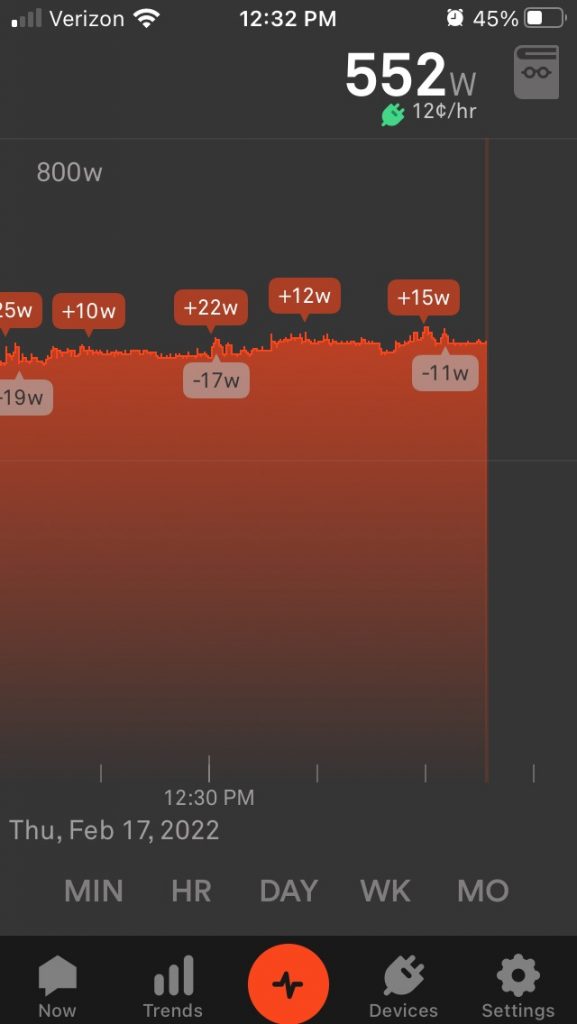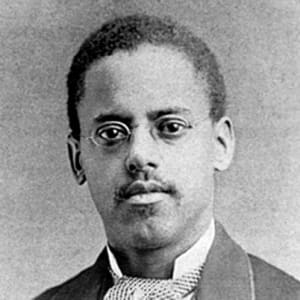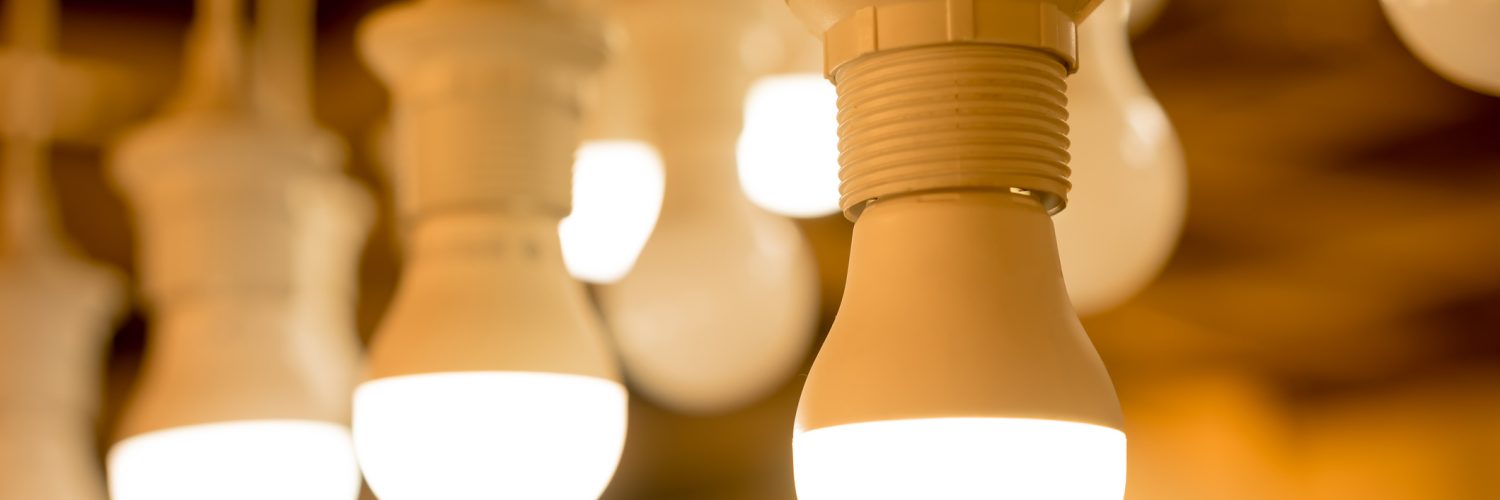If your home is like most, your lighting fixtures use a mix of different bulbs that were screwed into your lamps as old bulbs failed. Lighting accounts for about 15% of the average electricity bill, so thinking through your lighting choices can lead to a noticeable reduction in your costs.
Analyzing Your Home’s Lighting
The three most common types of light bulbs are compact fluorescent lights (CFLs), light emitting diodes (LEDs), and incandescents. These typically consume 13-15 Watts, 6-8 Watts, and around 60 Watts, respectively.
A light bulb’s efficiency (or efficacy) is a measure of emitted light (lumens) divided by the power the bulb draws (watts). A bulb that is 100 percent efficient at converting energy into light has an efficacy of 683 lm/W. There are no light bulbs available today that come close to that efficiency but here’s how the most widely available light bulb types compare.
As you can tell, by far the biggest gains in efficiency come from switching out your incandescent bulbs and replacing them with either CFLs or LEDs. You can run five LED light bulbs using the same amount of electricity you’d use for one incandescent bulb. While the price of LED bulbs is about 7x the cost of incandescents, the Department of Energy reports that a 60W incandescent bulb will last for approximately 1,000 hours while a similarly-bright 12W LED bulb should last about 25,000 hours. And while CFLs are less expensive than LEDs initially, analyses show that the longer lifetime of LEDs translates into lower costs overall.
In 2007, President George W. Bush signed into law the first national light bulb efficiency standards. In 2012 all new bulbs were required to use 28 percent less power than existing bulbs, which led to significant electricity savings as consumers adopted halogens, fluorescents and LEDs. The next phase of these standards, which ends the sale of lightbulbs that put out less than 45 lumens per watt, was delayed by the Trump administration but is currently moving forward. As the effects of those higher efficiency standards are felt, most incandescent bulbs will become obsolete, with an estimated savings of $100 per household annually.
But in the meantime, about 30 percent of standard bulbs sold in the United States in 2020 (excluding California, which phased out most halogen and incandescent light bulbs in 2020) were still incandescent or halogen bulbs.
The average home uses 40 light bulbs, and swapping out several bulbs at once can get expensive. To get the maximum savings, take a staged approach, targeting the biggest potential savings first.
1. Identify high wattage bulbs. Incandescents that use 60W or more are good candidates for replacement. Don’t overlook ceiling lights that are replaced less frequently but are often 60W or more.
2. Target lights that stay on a lot. Do your kitchen or family room lights stay on most of the day? You can add up their total wattage and figure out how many hours they’re on for an exact measure of their usage. But even without doing the math, you can assume that any lighting that’s on for many hours a month is a good candidate for replacement with more efficient bulbs– and less frequent use if possible.
3. Don’t forget outdoor lights. Many homes have outdoor lights on timers or dusk-to-dawn light sensors that keep the lights burning for hours every evening. Replace them with efficient bulbs that have built-in motion sensors and you’ll save money while maintaining your home’s security. Also, reducing outdoor lighting helps both migrating birds and your local insect population.
4. Look for light clusters. Although single light bulbs, particularly CFLs and LEDs, do not consume a lot of power, devices such as vanity lights, chandeliers, and recessed ceiling lights that turn on with a single switch are all good candidates for more efficient light bulbs and bigger collective savings.
5. Don’t waste your savings. Studies show that when cities switch to more efficient bulbs for street lights, they install more street lights and turn them on longer, reducing their potential savings. Don’t fall into the trap of getting more efficient bulbs but then leaving them on and adding up your kilowatt hours. Your behavior is the biggest factor in home energy savings, so turn off the lights when you’re not in the room!
The Data Science of Light Bulbs
A common question for the Sense data science team is “why is it so hard to detect light bulbs?” The simple answer is that high efficiency light bulbs don’t draw a lot of power, making their electrical signatures often indistinguishable from the background energy noise in your home. Incandescent bulbs have a more distinctive energy signature and use more power, so they are typically detected in the Sense app.
Take a look at this Power Meter screen shot, which shows the electrical activity in a Sense employee’s home during a recent weekday. Two laptops with monitors are in use, along with various lights, a gas furnace with an electrical ignition and a radon fan. The home has natural gas appliances for heating, laundry and the kitchen stove. Even with minimal activity, the power constantly fluctuates within a 10-25W range as devices use varying amounts of electricity in their normal operation, making it hard to see if a light bulb is turning on or off against this background variation.

Although light bulbs individually use relatively low amounts of energy compared to major appliances like a dishwasher or dryer, our data science team does have a couple of tricks up its sleeve to help detect them. For instance, light clusters like chandeliers turn on simultaneously, so the increase in power consumption has a stronger electrical signal that’s easier to identify.
Lighting can be associated with other significant appliances. For example, it’s not unusual to have one switch that turns on a bathroom light and fan. The Sense energy disaggregation algorithm can make use of these associations to improve detection performance.
The Sense app will often detect light bulbs inside refrigerators, ovens and other appliances, and label them “Appliance Light.” Appliance bulbs are designed with stronger filaments and shatterproof glass to help them withstand the extreme temperatures inside appliances.
In your Sense app, higher wattage light bulbs may be detected as unknown devices. You can participate in device detection by renaming devices identified in the Sense app. As the data science team grows its database of labeled light bulbs, with your help, we can fine tune our feature extraction and machine learning algorithms using the annotated data. The more data, the better!
If you want to control your lighting, take advantage of smart home integrations supported in the Sense app. You can track and control Philips Hue Lighting systems, both to help provide accurate detection of these light bulbs, but also to provide a simple way to turn your LED lights on and off directly from the Sense app. Similarly, you can use some energy-aware smart plugs that integrate with the Sense app to track and control any device in the home, including lighting.
The Hidden History of Lighting Innovation
Most of us know about Thomas Edison’s role as the inventor of modern lighting. But did you know that an African American inventor patented improvements to carbon filaments that made them practical for the mass market?
Born in Massachusetts in 1848, Lewis Latimer worked as an assistant to Alexander Graham Bell, drawing the blueprints for Bell’s patent for the telephone in 1876. Four years later, he joined the U.S. Electric Lighting Company—the same year that Thomas Edison patented a lightbulb with a carbonized bamboo filament that provided steady light—but it burnt out quickly.

Working with Edison’s research team, Latimer made a carbon filament that lasted longer by encasing it in cardboard and he patented a process to manufacture it efficiently. His invention made incandescent lighting more practical and affordable, helping light bulbs gain market acceptance. Brighter, more durable tungsten light bulbs were invented in the early 1900s and eventually replaced carbon filaments.
February is Black History Month, an opportunity to appreciate diversity and recognize the contributions of creative thinkers like Lewis Latimer. At Sense, we are building on the work of innovators like Lewis who helped to shape the modern home with their inventions.




















